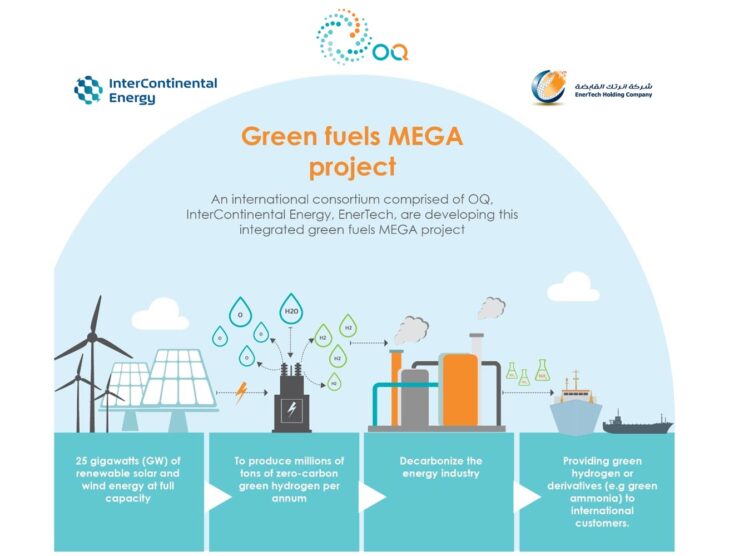
Consortium to develop Oman integrated green fuels mega project
An integrated green fuels mega project in Oman is being developed by an international consortium comprised of OQ, the Sultanate of Oman’s global integrated energy company, InterContinental Energy, the leading dedicated green fuels developer, and EnerTech, a Kuwait government-backed clean energy investor and developer.
The consortium has been collaborating on the project for more than three years. The project will consist of 25 gigawatts (GW) of renewable solar and wind energy at full capacity to produce millions of tons of zero-carbon green hydrogen per annum. The hydrogen can be used locally, exported directly, or converted into green ammonia for international export. The consortium partners will leverage their broad existing commercial relationships and partnerships to secure long-term product sales agreements.
Given the site’s strategic location between Europe and Asia, as well as excellent solar irradiance and wind resources facing the Arabian Sea, the development is well positioned to offer a reliable supply of green fuels globally at a highly competitive price.
Green hydrogen is expected to grow into a USD2.5 trillion market by 2050.1 Demand comes from the shipping sector, which requires green ammonia for its significant decarbonization needs, the aviation sector, which will utilise synthetic fuels made from green hydrogen, parts of the ground transportation sector, such as rail and trucking, which are expected to adopt green hydrogen as a fuel source, as well as heavy industries in North West Europe that will use green hydrogen to fuel their industrial processes including the production of steel. In addition, power companies across East Asia who have relied on coal and gas are planning to transition to green ammonia in the future to reduce their carbon footprint.
The consortium has been conducting wind and solar monitoring analysis in the Al Wusta Governorate in Central Oman since 2019. Renewable power generation will benefit from very high and stable levels of solar and wind energy, exhibiting the optimal diurnal profile of strong wind at night and reliable sun during the day. The project is also located near the coast for seawater intake and electrolysis. Existing energy infrastructure in Oman provides additional future options to develop synthetic fuels for the aviation sector, which will be critical for decarbonization.
The project will help transform Oman’s skills base and technical expertise in renewable energy, providing a significant number of high value jobs during site construction and operation. Given the amount of equipment required at a project of this scale, it could also support the development of Oman’s renewable energy supply chain manufacturing and expertise.









